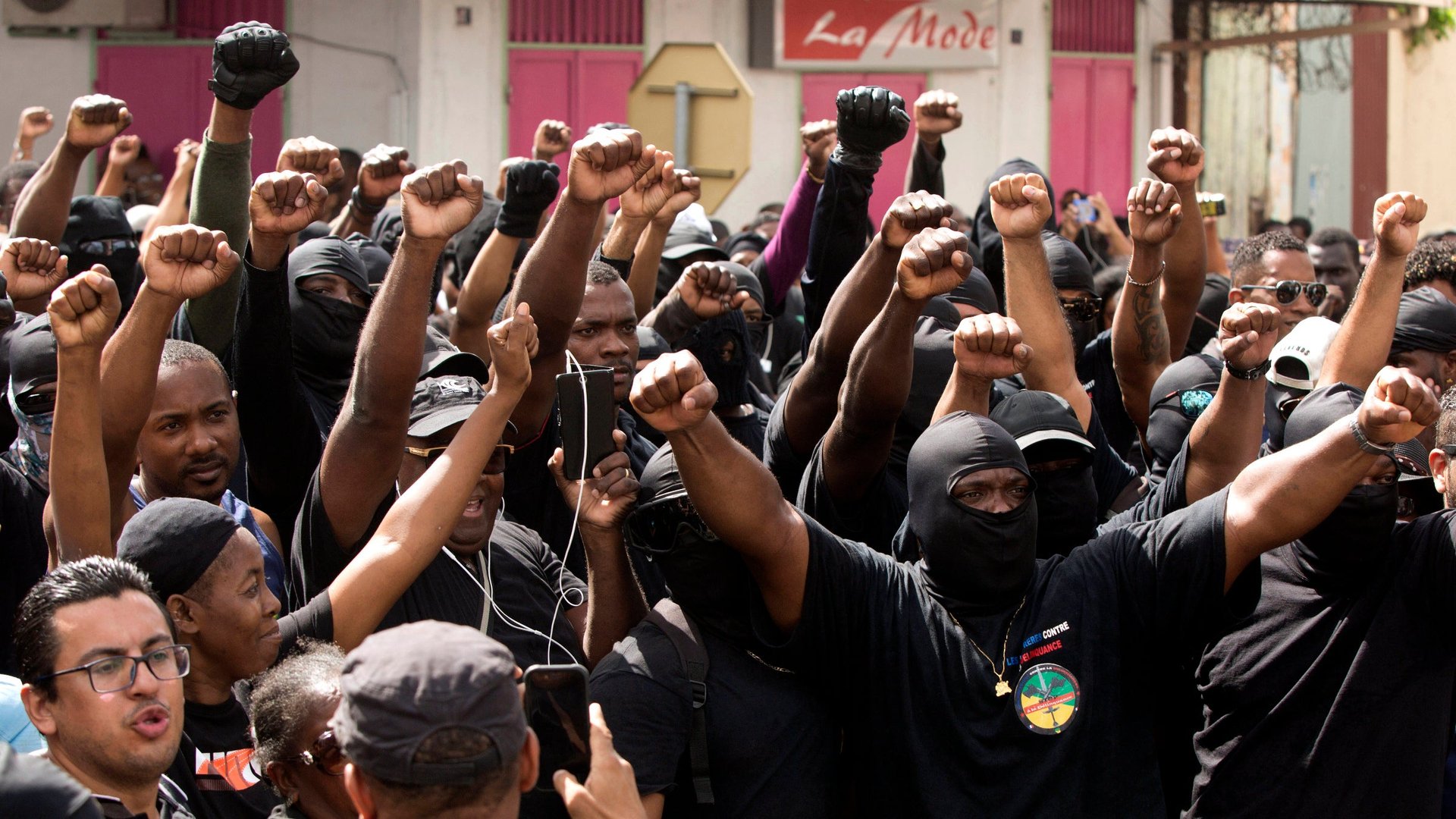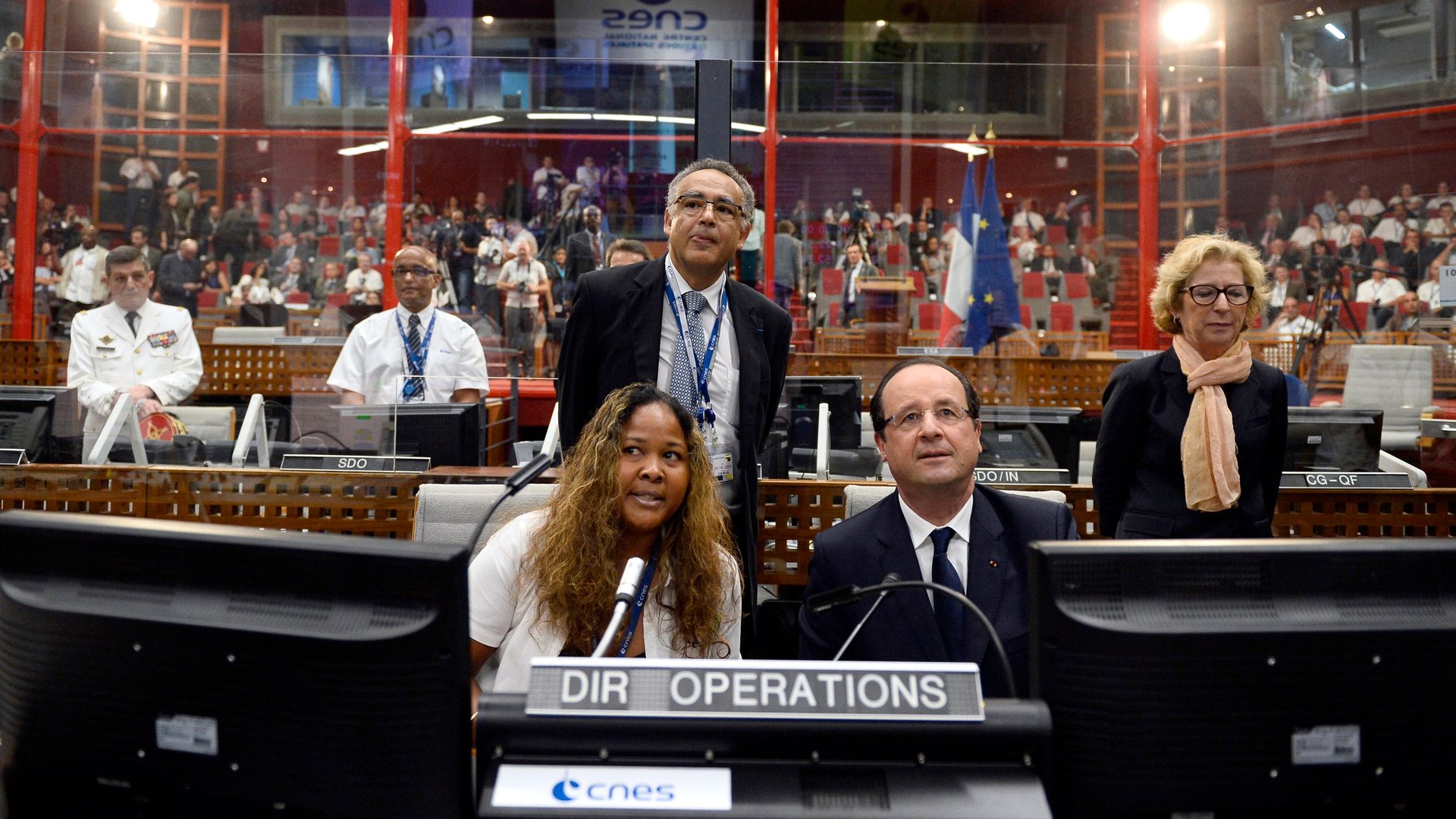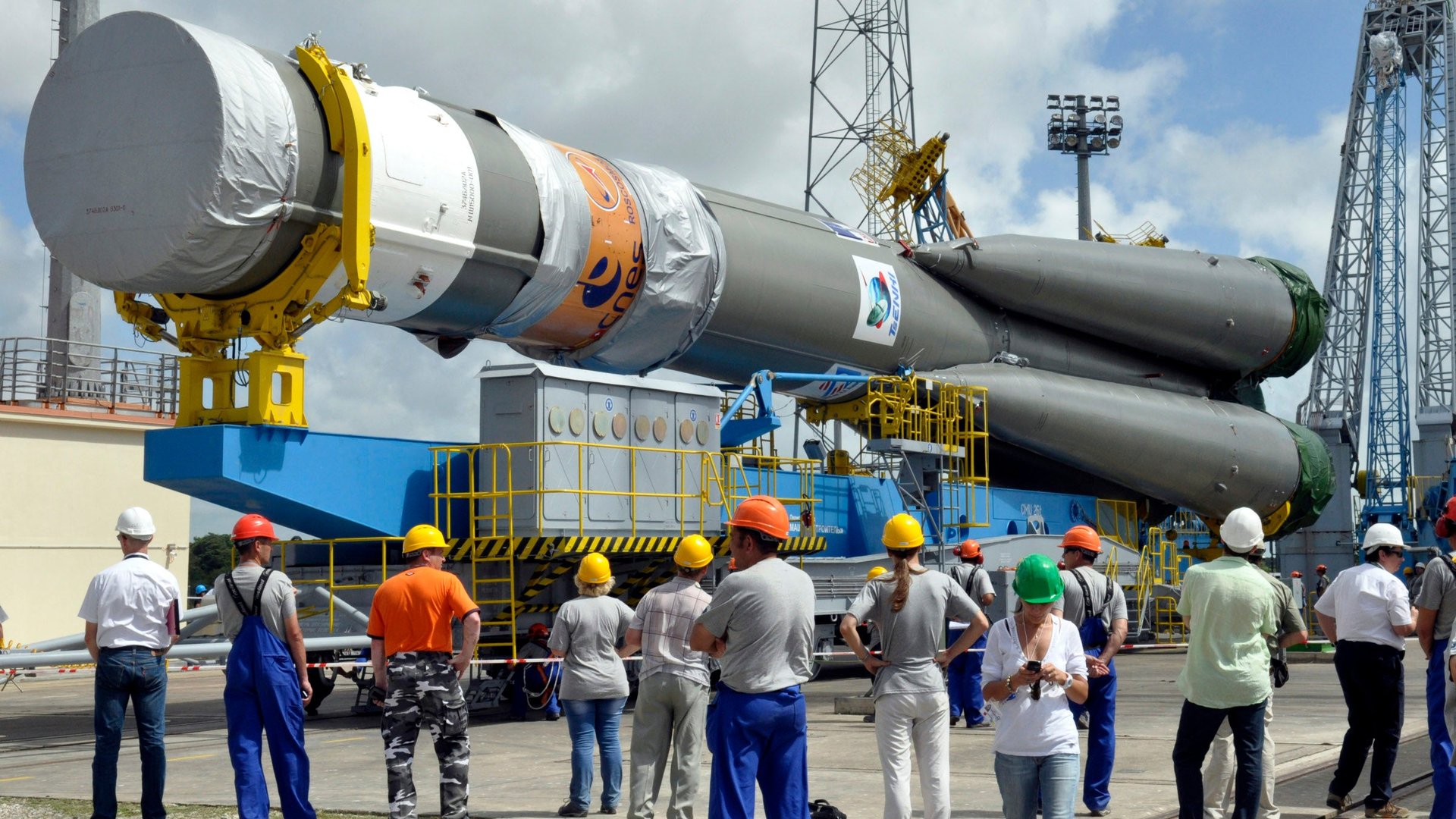How a handful of South American protestors took Europe’s space program hostage
Cayenne, French Guiana


Cayenne, French Guiana
The Guiana Space Center in Kourou, French Guiana—a tiny territory wedged into the peak of South America between Suriname and Brazil—hosted unexpected visitors on the afternoon of April 4.
A protest march, estimated about 10,000 strong, advanced on the space center and was standing at the gates, chanting their movement’s rallying cry, “Nou bon ké sa,” approximately “we’ve had enough,” in Guianese Creole. On the other side of the gate, riot police, shaded from the brutal sun in the covered beds of camouflage trucks, looked on.
In an apparent attempt to defuse tensions, a delegation of protestors and union leaders had been invited inside to speak with the space center’s director. And now they were refusing to leave.
“We’re not going to move,” Manuel Jean-Baptiste, a protestor, told the center’s director, according to Agence France-Presse. “We want the billions we asked for.”
The impromptu occupation was part of a larger protest movement against conditions in the French overseas department, a political status approximately equivalent to that of a US state. The action was intended to attract the attention of Europe, said Jean-José Mathias, an employee of the space center and member of the Guianese Workers’ Union.
“It was a symbolic action to make France and Europe aware” of the problems in the department, he told Quartz. French Guiana has an unemployment rate twice that of France, and a homicide rate 14 times that of the mainland.
For the handful of protestors in South America, mostly clad in black t-shirts and makeshift balaclavas, attracting the attention of European governments might seem like an unlikely goal. But their movement has already succeeded, largely thanks to one extremely valuable bargaining chip. By blocking launches at the Guiana Space Center, the protestors are threatening the entire European space program.
Desperate times, desperate measures
For more than three weeks, French Guiana has been effectively shut down by protests and a general strike. The movement has closed schools, grounded flights, and stranded cargo ships of goods in the capital Cayenne’s port. The territory’s few highways are blocked. Long lines of cars and people carrying jerrycans flood gas stations after the infrequent fuel deliveries. Fresh vegetables have disappeared from grocery shelves, and money in ATMs is increasingly scarce.
The movement is a reaction to the department’s chronic problems. Besides joblessness and crime, wages are on average about a third lower than on the mainland but the cost of living—especially food—is significantly higher. The territory produces little food, and many products are imported from Europe.
Infrastructure, too, is severely lacking. Roads are few and in poor condition. In the country’s interior, people travel in canoes, helicopters, and bush planes. According to the governmental French Guiana Water Office, nearly 20% of the population lacks direct access to potable water, and medical services and schools are inaccessible for many of the territory’s residents.
“Young people don’t have a future,” Davy Rimane, the secretary-general of the Union of Guianan Lighting Workers, told Quartz. “Businesses are closing.”
Current conditions are rooted in the territory’s colonial past. An agricultural and slaving colony since the 17th century, much of the agricultural infrastructure disappeared after the discovery of gold in the mid-1800s. After the abolition of slavery, the territory became a penal colony, whose inhabitants included the political prisoner Albert Dreyfus and Henri Charrière, who would later write Papillon. The prison did not cease operations until 1947.
In 1946, the French government, responding to assimilation movements within its overseas territories, passed a law turning turning French Guiana into a department, along with its overseas holdings of Martinique, Guadeloupe, and La Réunion. The residents of French Guiana are French citizens and the territory uses the euro. Recognizing the benefits of being part of France, residents have had little desire to become independent. But despite its status, the territory lags far behind France.
“Once French Guiana became a department, they launched plans to develop it. But they didn’t succeed in elevating living conditions like in France,” said Serge Mam Lam Fouck, a historian and professor at the University of French Guiana. “The new department was centuries behind.”
Despite its troubles, French Guiana boasts the highest GDP per capita in South America, €15,820 as of 2014. With its links to mainland Europe, French Guiana has long been an attractive destination for migrants from Suriname, Brazil, and Haiti. In the 1960s, the department’s population was around 60,000; now it is 250,000, with more than a third of French Guianese residents born in other countries. This migration has exacerbated the territory’s problems.
“The infrastructure didn’t keep up,” said Mam Lam Fouck. “The construction of schools didn’t keep up, the construction of medical facilities didn’t keep up.”

Europe’s stairway to space
Despite its crumbling infrastructure, the territory is home to some of the world’s most advanced technology. In 1965, construction of the Guiana Space Center began, and the first rocket was launched in 1968. Last year, CSG—an acronym from the French name Centre Spatial Guyanais—was the second-busiest spaceport in the world after Cape Canaveral in the United States.
Eleven different orbital launches took place there in 2016. Arianespace, the European company which operates the rockets launched at the center, was among the busiest launch organizations in the world, putting just one fewer into space than its American competitor United Launch Alliance and matching the tally by China’s state-backed rocket builder.
Arianespace is essentially owned by Europe’s state aerospace industry; France owns the bulk of its capital through a joint venture between Airbus and Safran Launchers, with the second-largest share held by German firms. Because CSG is its primary launch site, the European Space Agency and the French national space agency have also invested in facilities there.
Why do European space launches happen thousands of miles from Europe? Launches are easier near the equator, where rockets can take advantage of the earth’s rotation for an extra boost. The remoteness of the area and its proximity to open water means that debris from botched launches is less likely to cause harm. The territory does not suffer from earthquakes or tropical storms.
At the moment, however, it suffers from political unrest. Last year, Arianespace earned €1.4 billion from its eleven launches; and similar revenue from the remaining nine launches scheduled this year are now in jeopardy.
“Operations and launches should resume as soon as the conditions in French Guiana make this possible,” an Arianespace spokesperson told Quartz.
A gap in revenue could mean delays in the development of the company’s next-generation rocket, Ariane 6, which is designed to compete with new, cheap rockets being designed in the United States. Prolonged unrest in French Guiana could even make satellite operators reluctant to hire the company to fly their expensive satellites.
“If we can take up launch campaigns again in the next few days, we could do our initial planned twelve launches for 2017, if all goes well for the rest of the year,” Daniel Neuenschwander, director of space transportation for the European Space Agency, told Quartz. “If we are missing that in the next two weeks, then we are seriously endangering the twelve launches. We will only know at the end of the conflict. I sincerely hope that this conflict ends soon.”
The next ESA mission expected to launch from CSG is a communications satellite in October, but postponed commercial satellite launches expected in April and June could mean a cascade of delays pushing back the entire schedule.
Neuenschwander described Europe’s investment in the spaceport as a boost to French Guiana as well as the space program, estimating that about 15% of the country’s economic production is connected to the spaceport.

“Let French Guiana Lift Off”
Economic benefits or no, the space center has become a focal point of resentment in the department. There’s a widespread sense that mainland France (“la métropole”) is indifferent to the needs of the French Guianese population, and its concern in the territory extends only so far as the space center. But that concern means the space center is also the movement’s most powerful source of leverage.
“It’s a number one global industry, and just next to it, in Grand-Santi, in Sinnamary [nearby towns], there’s no potable water, there’s no electricity,” said Bertrand Razan, a protestor manning a roadblock in front of the university. “This situation is not sustainable. It’s not normal.”
“There are rails to transport satellites onto a rocket, and there’s no train, no metro, no night bus,” Stéphane Miatti, a receptionist, said at a March 29 protest in Cayenne.
This sense of injustice has even informed the name of the group behind the protests: “Pou Lagwiyann Dékolé,” a Creole phrase roughly translatable as “Let French Guiana Lift Off.” It’s a twist on one of the refrains of the movement, pulled from a 17-year-old protest track from the now-deceased Guianese rapper Freaky Fan: “La fusée décolle mais la Guyane reste au sol,”—”the rocket takes off, but French Guiana stays on the ground.”
Negotiations continue between the Pou Lagwiyann Dékolé and the French government. The collective has issued a document of more than 400 demands, touching on everything from education to security to fisheries. Guianese negotiators turned down an initial offer worth approximately 1.1 billion euros from the government, demanding instead an aid package worth €3 billion.
Most recently, French President François Hollande wrote Guianese officials calling for an end to disruptions, but saying that “the government and I have not closed the door on discussions,” though he called the demonstrators’ proposals “ambitious.”
“The foundations—education, health, energy—if we don’t have these things we need, in ten years we’ll have to protest again,” said Rimane, of the Guianese Lighting Workers’ Union, at the April 4 march on the space center. “That’s not logical.”
On March 20, protestors, including striking workers from the CSG, blocked the roundabout that leads to the complex, preventing the launch of a rocket carrying a Brazilian satellite and a South Korean satellite.
“We knew well that, by blocking Europe’s space center, there would be a global repercussion,” said Mathias, who, nearly a month ago was among the first protesters to block the roundabout. “It’s real pressure.”
That night, protestors spent an uncomfortable and hungry night in the CSG’s conference room. Talks with the director had been unsatisfying, and the movement’s representatives left the next morning, calling for more protests and roadblocks.
Mathias said the message to Europe had been sent. “It was to tell them, look, if you don’t unblock the situation in French Guiana, the space center will stay blocked,” he said.
Tim Fernholz contributed additional reporting to this story.